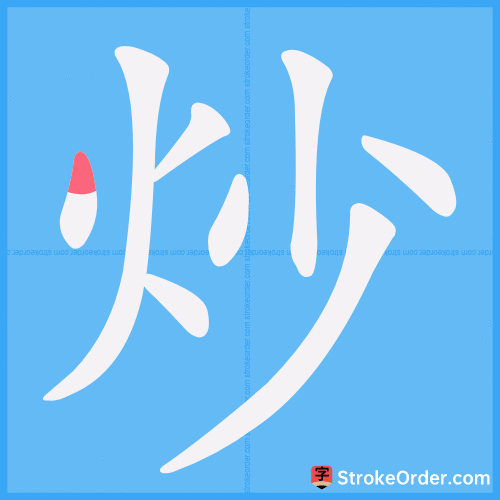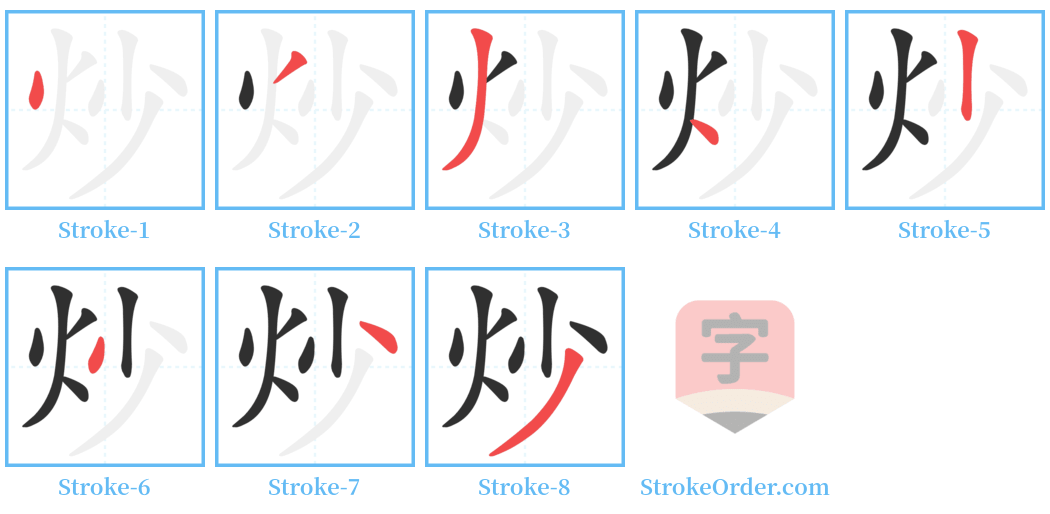炒 Stroke Order
Animated Stroke Order of 炒

Stroke Order Diagrams for 炒

Step-by-Step Handwriting Guide for 炒

Learn to Write Chinese Characters with Video Tutorials
Watch the video of writing the Chinese character "炒", learn the correct stroke order (笔顺) of the character "炒", and master the standard way of writing the character "炒".
Free Printable Handwriting Practice with Stroke Order: 炒
Printable Writing Practice Worksheet of "炒" in Portrait Orientation (Tian Zi Ge)

Printable Writing Practice Worksheet of "炒" in Landscape Orientation (Tian Zi Ge)

Information of 炒
Pinyin
chǎo
Radical
火
Strokes
8 strokes
Usage
★★★★★
Definition
saute / pan-fry / to fry / fried
炒 [chǎo]
Verb
1. Cooking method: Putting food or other items in a pan, heating and stirring until cooked or dried, usually with a small amount of cooking oil.
例如: 炒肉丝 (stir-fried shredded pork); 炒花生 (stir-fried peanuts).
2. One of the methods for processing traditional Chinese medicine: Heating and stirring medicinal materials in a pan until certain requirements are met. The process without any additional materials is called 清炒 (light fry); with additional materials, it can involve methods like 麸炒 (wheat bran fry), 土炒 (soil fry), 米炒 (rice fry), 酒炒 (wine fry), 醋炒 (vinegar fry), etc.
3. To make noise: synonymous with 吵 (to make noise).
例如: 炒炒 (making noise, many people talking at once); 炒刺 (to make a racket).
This character has its original meaning related to frying and dry cooking. The character is phono-semantic, consisting of the meaning component "fire" and the sound component "少".
炒 [chǎo]
Verb
1. Cooking method: Putting food or other items in a pan, heating and stirring until cooked or dried, usually with a small amount of cooking oil.
For example: stir-fried shredded pork; stir-fried peanuts.
2. One of the methods for processing traditional Chinese medicine: Heating and stirring medicinal materials in a pan until certain requirements are met. The process without any additional materials is called light fry; with additional materials, it can involve methods like wheat bran fry, soil fry, rice fry, wine fry, vinegar fry, etc.
3. To make noise: synonymous with to make noise.
For example: making noise, many people talking at once; to make a racket.
This character has its original meaning related to frying and dry cooking. The character is phono-semantic, consisting of the meaning component "fire" and the sound component "少".
to stir-fry rapidly using a high flame / to conduct a media blitz / to manipulate a stock market through large-scale buying and selling
Input Method for 炒
Pinyin
chao3
Wubi
oitt
Cangjie
ffh
Zhengma
uokm
Four Corner
99820
Unicode
U+7092
Same Pronunciation Characters